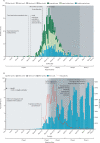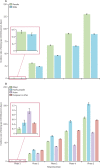COVID-19 in New Zealand and the impact of the national response: a descriptive epidemiological study
- PMID: 33065023
- PMCID: PMC7553903
- DOI: 10.1016/S2468-2667(20)30225-5
COVID-19 in New Zealand and the impact of the national response: a descriptive epidemiological study
Abstract
Background: In early 2020, during the COVID-19 pandemic, New Zealand implemented graduated, risk-informed national COVID-19 suppression measures aimed at disease elimination. We investigated their impacts on the epidemiology of the first wave of COVID-19 in the country and response performance measures.
Methods: We did a descriptive epidemiological study of all laboratory-confirmed and probable cases of COVID-19 and all patients tested for severe acute respiratory syndrome coronavirus 2 (SARS-CoV-2) in New Zealand from Feb 2 to May 13, 2020, after which time community transmission ceased. We extracted data from the national notifiable diseases database and the national SARS-CoV-2 test results repository. Demographic features and disease outcomes, transmission patterns (source of infection, outbreaks, household transmission), time-to-event intervals, and testing coverage were described over five phases of the response, capturing different levels of non-pharmaceutical interventions. Risk factors for severe outcomes (hospitalisation or death) were examined with multivariable logistic regression and time-to-event intervals were analysed by fitting parametric distributions using maximum likelihood estimation.
Findings: 1503 cases were detected over the study period, including 95 (6·3%) hospital admissions and 22 (1·5%) COVID-19 deaths. The estimated case infection rate per million people per day peaked at 8·5 (95% CI 7·6-9·4) during the 10-day period of rapid response escalation, declining to 3·2 (2·8-3·7) in the start of lockdown and progressively thereafter. 1034 (69%) cases were imported or import related, tending to be younger adults, of European ethnicity, and of higher socioeconomic status. 702 (47%) cases were linked to 34 outbreaks. Severe outcomes were associated with locally acquired infection (crude odds ratio [OR] 2·32 [95% CI 1·40-3·82] compared with imported), older age (adjusted OR ranging from 2·72 [1·40-5·30] for 50-64 year olds to 8·25 [2·59-26·31] for people aged ≥80 years compared with 20-34 year olds), aged residential care residency (adjusted OR 3·86 [1·59-9·35]), and Pacific peoples (adjusted OR 2·76 [1·14-6·68]) and Asian (2·15 [1·10-4·20]) ethnicities relative to European or other. Times from illness onset to notification and isolation progressively decreased and testing increased over the study period, with few disparities and increasing coverage of females, Māori, Pacific peoples, and lower socioeconomic groups.
Interpretation: New Zealand's response resulted in low relative burden of disease, low levels of population disease disparities, and the initial achievement of COVID-19 elimination.
Funding: Ministry of Business Innovation and Employment Strategic Scientific Investment Fund, and Ministry of Health, New Zealand.
Copyright © 2020 The Author(s). Published by Elsevier Ltd. This is an Open Access article under the CC BY-NC-ND 4.0 license. Published by Elsevier Ltd.. All rights reserved.
Figures



Comment in
-
Lessons from New Zealand's COVID-19 outbreak response.Lancet Public Health. 2020 Nov;5(11):e569-e570. doi: 10.1016/S2468-2667(20)30237-1. Epub 2020 Oct 14. Lancet Public Health. 2020. PMID: 33065024 Free PMC article. No abstract available.
Similar articles
-
Epidemiology and transmission of COVID-19 in 391 cases and 1286 of their close contacts in Shenzhen, China: a retrospective cohort study.Lancet Infect Dis. 2020 Aug;20(8):911-919. doi: 10.1016/S1473-3099(20)30287-5. Epub 2020 Apr 27. Lancet Infect Dis. 2020. PMID: 32353347 Free PMC article.
-
Determining the optimal strategy for reopening schools, the impact of test and trace interventions, and the risk of occurrence of a second COVID-19 epidemic wave in the UK: a modelling study.Lancet Child Adolesc Health. 2020 Nov;4(11):817-827. doi: 10.1016/S2352-4642(20)30250-9. Epub 2020 Aug 3. Lancet Child Adolesc Health. 2020. PMID: 32758453 Free PMC article.
-
COVID-19, Australia: Epidemiology Report 18 (Fortnightly reporting period ending 7 June 2020).Commun Dis Intell (2018). 2020 Jun 17;44. doi: 10.33321/cdi.2020.44.52. Commun Dis Intell (2018). 2020. PMID: 32552623
-
COVID-19 in Children: Clinical Approach and Management.Indian J Pediatr. 2020 Jun;87(6):433-442. doi: 10.1007/s12098-020-03292-1. Epub 2020 Apr 27. Indian J Pediatr. 2020. PMID: 32338347 Free PMC article. Review.
-
Pathophysiology, Transmission, Diagnosis, and Treatment of Coronavirus Disease 2019 (COVID-19): A Review.JAMA. 2020 Aug 25;324(8):782-793. doi: 10.1001/jama.2020.12839. JAMA. 2020. PMID: 32648899 Review.
Cited by
-
Sensitivity of wastewater-based epidemiology for detection of SARS-CoV-2 RNA in a low prevalence setting.Water Res. 2022 Mar 1;211:118032. doi: 10.1016/j.watres.2021.118032. Epub 2022 Jan 2. Water Res. 2022. PMID: 35042077 Free PMC article.
-
New Zealand border restrictions amidst COVID-19 and their impacts on temporary migrant workers.Asian Pac Migr J. 2022 Sep;31(3):312-323. doi: 10.1177/01171968221126206. Asian Pac Migr J. 2022. PMID: 38603233 Free PMC article.
-
From impossible to possible: the lessons from the control of recent COVID-19 outbreaks in China.Int J Biol Sci. 2021 Apr 10;17(6):1600-1612. doi: 10.7150/ijbs.58906. eCollection 2021. Int J Biol Sci. 2021. PMID: 33907524 Free PMC article. Review.
-
Age-dependence of healthcare interventions for COVID-19 in Ontario, Canada.BMC Public Health. 2021 Apr 12;21(1):706. doi: 10.1186/s12889-021-10611-4. BMC Public Health. 2021. PMID: 33845807 Free PMC article.
-
On topological properties of COVID-19: predicting and assessing pandemic risk with network statistics.Sci Rep. 2021 Mar 4;11(1):5112. doi: 10.1038/s41598-021-84094-z. Sci Rep. 2021. PMID: 33664280 Free PMC article.
References
-
- WHO . World Health Organization; Geneva: 2020. Report of the WHO-China Joint Mission on coronavirus disease 2019 (COVID-19)
Publication types
MeSH terms
LinkOut - more resources
Full Text Sources
Miscellaneous

